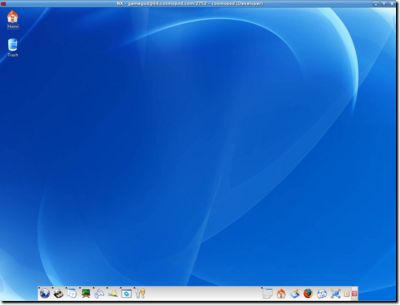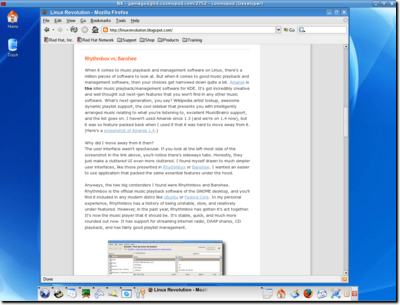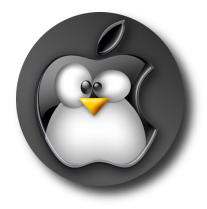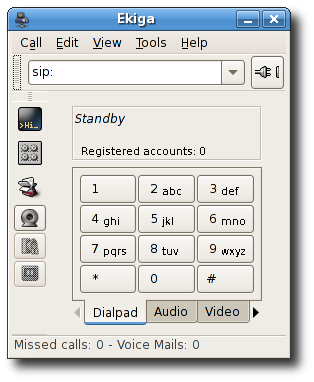Update Sept 18/07: I realize a lot of people are still reading this article, and I'd live to give a big fat WARNING to everyone that this comparison is totally out-of-date now. Both Banshee and Rhythmbox have seen several releases since I wrote this article, and they've both improved tremendously. At the moment, my favourite player is Rhythmbox (0.11.2 on Ubuntu 7.10), as it's got a bunch new killer features that I can't live without (play queue, Magnatune+Jamendo integration, Last.FM). It's still worth checking out both apps though.
When it comes to music playback and management software on Linux, there's a million pieces of software to look at. But when it comes to good music playback and management software, then your choices get narrowed down quite a bit. Amarok is the killer music playback/management software for KDE. It's got incredibly creative and well thought out next-gen features that you won't find in any other music software. What's next-generation, you say? Wikipedia artist lookup, awesome dynamic playlist support, the cool sidebar that presents you with intelligently arranged music relating to what you're listening to, excellent MusicBrainz support, and the list goes on. I haven't used Amarok since 1.3 (and we're on 1.4 now), but it was so feature-packed back when I used it that it was hard to move away from it. (Here's a screenshot of Amarok 1.4.)
Why did I move away from it then?
The user interface wasn't spectacular. If you look at the left-most side of the screenshot in the link above, you'll notice there's sideways tabs. Honestly, they just make a cluttered UI even more cluttered. I found myself drawn to much simpler user interfaces, like those presented in Rhythmbox or Banshee. I wanted an easier to use application that packed the same essential features under the hood.
Anyways, the two big contenders I found were Rhythmbox and Banshee. Rhythmbox is the official music playback software of the GNOME desktop, and you'll find it included in any modern distro like Ubuntu or Fedora Core. In my personal experience, Rhythmbox has a history of being unstable, slow, and relatively under-featured. However, in the past year, Rhythmbox has gotten it's act together. It's now the music player that it should be. It's stable, quick, and much more rounded out now. It has support for streaming internet radio, DAAP shares, CD playback, and has fairly good playlist management.

However, Banshee also caught my eye a while ago. One of the main reasons I wanted to upgrade to Ubuntu 5.10 was to be able to run Banshee. Why was I so excited?
You tell me:
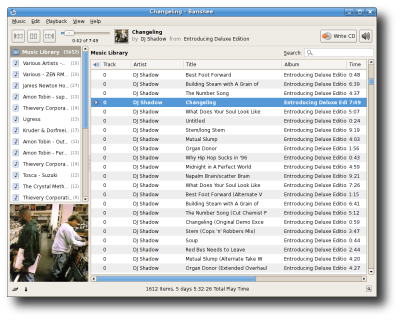
The interface was exactly what I was looking for. I wanted an easy and quick way to access my entire collection in a single list, easy playlist creation, and cool features that didn't look like they were tacked on. Banshee is smart too. If you select all the songs from an album in the "Music Library", then right click and go to "Add to Playlist", then "New Playlist", it'll automatically create a playlist with the name of the album.
Banshee also has a well designed plugin system, awesome iPod support, and CD burning capabilities. All of this is wrapped up to make one of the most solid and promising next-generation apps of the Linux desktop.
In the newest version of Rhythmbox, the interface was also redesigned:

Here's a quick comparison of the two pieces of software:
Rhythmbox
- Audioscrobbler/Last.FM support
- Streaming internet radio support
- CD Burning
- Playlist importing
- Automatic playlists
- Multimedia keys support
- DAAP support
- Play queue
- Podcast support
- Filesystem monitoring/Library watching (fam/gamin)
|
Banshee
- Audioscrobbler/Last.FM support
- Album Art
- Intelligent playlist management
- iPod support (with transcoding)
- CD Burning and Ripping
- Metadata fecthing
- Filesystem monitoring/Library watching (inotify?)
- Multimedia keys support
- DAAP support
|
As you can see from this comparison, both players have their advantages and disadvantages. However, I feel I should point out that Banshee is quite a young project, while Rhythmbox has been around for many years. The pace of development and level of polish with Banshee is partly due to it's use of
Mono. On top of this, many of the next-gen features in Rhythmbox such as DAAP support, podcast support, Audioscrobbler integration, and the redesigned interface have only been added very recently - and I think that's partly due to pressure from friendly competition with Banshee. (That's a good thing, by the way.)
So, should you use Rhythmbox or Banshee?
Your best bet is to wait until Dapper comes out in April (or the next version of your distro of choice) and to try them both out. By then, both pieces of software might have added many new features. Exciting stuff.
Additional reading and downloads:
Edit: Some readers at the Ubuntu forums have mentioned some good additional points. Because Banshee uses Mono, it can be a bit sluggish at times, and might not be suitable for slower PCs. Also, the ID3/ogg/other tag editing capabilities of both programs isn't great (which is odd for music
management software.) One more additional point of my own is that both players should experience a bit of a speed increase if you're using them built for GStreamer 0.10 (as they should be in Dapper)...
